This article needs additional citations for verification .(March 2010) |
Ronaldsway (Manx : Roonysvaie) is a place in the parish of Malew in the south of the Isle of Man, between the village of Ballasalla and the town of Castletown.
This article needs additional citations for verification .(March 2010) |
Ronaldsway (Manx : Roonysvaie) is a place in the parish of Malew in the south of the Isle of Man, between the village of Ballasalla and the town of Castletown.
It is notable as the location of Isle of Man Airport and historically of RNAS Ronaldsway, together with the adjoining customs free zone and industrial estate.

The place name is derived from the Old Norse personal name Rǫgnvaldr and the Old Norse element vað meaning "ford", or alternatively vágr meaning "large, narrow bay" as in Stornoway. It is possible that the eponym of Ronaldsway is Rǫgnvaldr Guðrøðarson, King of the Isles (died 1229). The site was once a landing place for Castle Rushen and Castletown. Ronaldsway first appears on record in the Chronicle of Mann , which documents an instance when Rǫgnvaldr's half-brother, Óláfr (died 1237), landed on the island in 1224, and confronted him for a share of the kingdom.
Ronaldsway is the site of the Battle of Ronaldsway, fought in October 1275, in which a Manx revolt led by Guðrøðr Magnússon (fl. 1275) was crushed by Scottish royal forces.
Ronaldsway is one of the 22 coastal weather stations whose conditions are reported in the BBC Shipping Forecast.
There is a request stop on the Isle of Man railway located just west of the Ronaldsway Industrial Estate on the Silverburn river.
BA Connect (BA CitiExpress) had an engineering base in Ronaldsway, employing 110 people. After Flybe acquired BA Connect, Flybe announced that it would discontinue the base. [1]
While the airfield runway at Ronaldsway Airport was being extended during the Second World War, a sunken-floored structure was uncovered dating from the third millennium BC in the late Neolithic era. The distinctive nature of the finds, including pots and stone tools, gave rise to the name Ronaldsway culture, and similar artefacts have been found elsewhere. [2]
Ronaldsway has an oceanic climate (Cfb) with short, mild summers and long, cool winters. Ronaldsway has very cloudy and rainy winters.
| Climate data for Ronaldsway, elevation: 16m (1981-2010) Extremes (1960 - present) | |||||||||||||
|---|---|---|---|---|---|---|---|---|---|---|---|---|---|
| Month | Jan | Feb | Mar | Apr | May | Jun | Jul | Aug | Sep | Oct | Nov | Dec | Year |
| Mean daily maximum °C (°F) | 8.2 (46.8) | 7.9 (46.2) | 9.2 (48.6) | 11.1 (52.0) | 14.1 (57.4) | 16.3 (61.3) | 18.1 (64.6) | 18.1 (64.6) | 16.3 (61.3) | 13.6 (56.5) | 10.9 (51.6) | 8.9 (48.0) | 12.8 (55.0) |
| Daily mean °C (°F) | 6.1 (43.0) | 5.7 (42.3) | 6.8 (44.2) | 8.3 (46.9) | 10.9 (51.6) | 13.3 (55.9) | 15.2 (59.4) | 15.3 (59.5) | 13.7 (56.7) | 11.3 (52.3) | 8.6 (47.5) | 6.7 (44.1) | 10.2 (50.4) |
| Mean daily minimum °C (°F) | 3.9 (39.0) | 3.4 (38.1) | 4.4 (39.9) | 5.4 (41.7) | 7.7 (45.9) | 10.2 (50.4) | 12.2 (54.0) | 12.4 (54.3) | 11.1 (52.0) | 8.9 (48.0) | 6.3 (43.3) | 4.5 (40.1) | 7.6 (45.7) |
| Average precipitation mm (inches) | 82.6 (3.25) | 57.5 (2.26) | 65.5 (2.58) | 55.7 (2.19) | 50.9 (2.00) | 58.1 (2.29) | 56.2 (2.21) | 65.3 (2.57) | 75.3 (2.96) | 102.5 (4.04) | 103.1 (4.06) | 91.8 (3.61) | 864.4 (34.03) |
| Average precipitation days | 14.0 | 10.6 | 11.8 | 9.9 | 9.7 | 9.8 | 9.0 | 10.8 | 11.1 | 14.1 | 15.2 | 13.9 | 140.1 |
| Mean monthly sunshine hours | 54.1 | 77.9 | 115.9 | 171.2 | 227.6 | 203.4 | 197.4 | 184.9 | 138.9 | 103.6 | 63.5 | 46.0 | 1,584.6 |
| Source: Met Office [3] | |||||||||||||

The Isle of Man or Mann, is a self-governing British Crown Dependency in the Irish Sea, between Great Britain and Ireland. It is recognized as one of the Celtic nations, and is the homeland of the Manx people, a Celtic ethnic group. As head of state, Charles III holds the title Lord of Mann and is represented by a Lieutenant Governor. The government of the United Kingdom is responsible for the isle's military defence and represents it abroad.
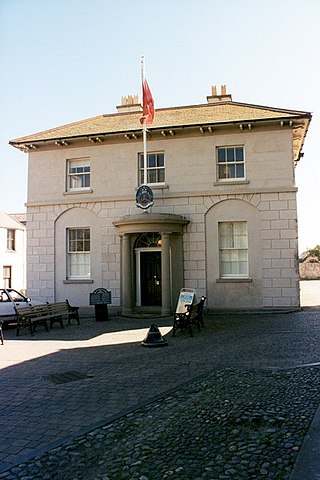
The Isle of Man had become physically separated from Great Britain and Ireland by 6500 BC. It appears that colonisation took place by sea sometime during the Mesolithic era. The island has been visited by various raiders and trading peoples over the years. After being settled by people from Ireland in the first millennium AD, the Isle of Man was converted to Christianity and then suffered raids by Vikings from Norway. After becoming subject to Norwegian suzerainty as part of the Kingdom of Mann and the Isles, the Isle of Man later became a possession of the Scottish and then the English crowns.
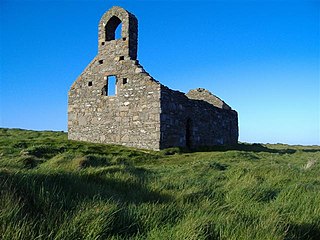
St Michael's Isle, more commonly referred to as Fort Island, is an island in Malew parish in the Isle of Man, noted for its attractive ruins. It covers an area of 5.14 hectares, is about 400 metres long from west to east, and is connected to the Langness Peninsula, near Derbyhaven, by a narrow causeway. The island itself is made of rocky slate and the soil is very acidic. Nevertheless, it has important communities of maritime plants.

Langness is a peninsula which protrudes two kilometres at the southern extremity of the Isle of Man. Signifying a cape or extended promontory, Langness literally means "long promontory" in Old Norse. Formerly an island, Langness was eventually joined to the mainland by the movement and deposition of material along Castletown Bay to form a tombolo. The small community of Derbyhaven is situated on the east coast of this isthmus, which lies close to Castletown, Isle of Man.

Castletown is a town in the Isle of Man, geographically within the historical parish of Malew but administered separately. Lying at the south of the island, it was the Manx capital until 1869. The centre of town is dominated by Castle Rushen, a well-preserved medieval castle, originally built for a Viking king.
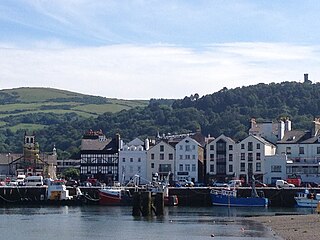
Ramsey is a coastal town in the north of the Isle of Man. It is the second largest town on the island after Douglas. Its population is 7,845 according to the 2016 Census. It has one of the biggest harbours on the island, and has a prominent derelict pier, called the Queen's Pier. It was formerly one of the main points of communication with Scotland. Ramsey has also been a route for several invasions by the Vikings and Scots.

Illiam Dhone or Illiam Dhône, also known as William Christian, was a Manx politician and depending on viewpoint, patriot, rebel or traitor. He was a son of Ewan Christian, a deemster. In Manx, Illiam Dhone literally translates to Brown William—an epithet he received due to his dark hair—and in English he was called Brown-haired William. Dhone was a significant figure in the Isle of Man during the English Civil War and the Manx Rebellion of 1651. He was executed for high treason in 1663. In the centuries after his death he has become a "martyr and folk-hero, a symbol of the Island's cherished freedoms and traditional rights".
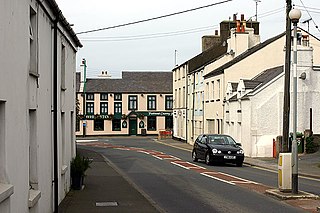
Ballasalla is a village in the parish of Malew in the south-east of the Isle of Man. The village is situated close to the Isle of Man Airport and 2 miles (3 km) north-east of the town of Castletown.

Isle of Man Airport is the main civilian airport on the Isle of Man. It is located in the south of the island at Ronaldsway near Castletown, 6 nautical miles southwest of Douglas, the island's capital. Along with the Isle of Man Sea Terminal, it is one of the two main gateways to the island. The airport has scheduled services to the United Kingdom and the Republic of Ireland.

Derbyhaven is a hamlet near Castletown in the southern parish of Malew, Isle of Man. It is located on the isthmus connecting Langness Peninsula to the rest of the island, on the bay of the same name, and also on Castletown Bay on the other side of the isthmus.

The Battle of Ronaldsway took place in 1275 at Ronaldsway in the southern part of the Isle of Man between a Scottish army and the Manx. The battle crushed the final attempt by the Manx to re-establish the Norse Sudreyar dynasty. As the battle resulted in the death of the last Norse King of Mann, Guðrøðr Magnússon, and the emigration to Norway of the remaining members of the Manx royal family, it also led to the firm establishment of Scottish rule on the Isle of Man.

Malew is one of the seventeen parishes of the Isle of Man.
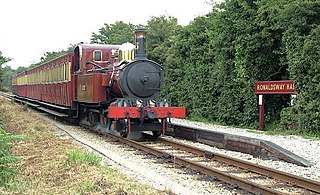
Ronaldsway Halt is a request stop on the Isle of Man Railway between Castletown and Ballasalla at Ronaldsway, near the Isle of Man Airport. Passengers wishing to board the train here can signal the driver to stop the train; to alight from the train the guard must be notified in advance.
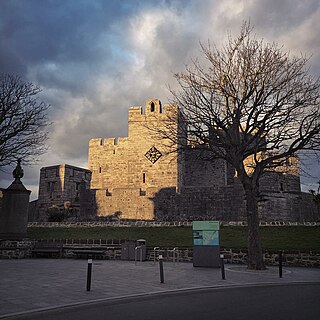
Castle Rushen is a medieval castle located in the Isle of Man's historic capital, Castletown, in the south of the island. It towers over the Market Square to the south-east and the harbour to the north-east. The castle is amongst the best examples of medieval castles in Europe and is still in use as a museum and educational centre.
Manx Airlines was an English-owned, Isle of Man-based airline that existed between 1982 and 2002. Its head office was located on the grounds of Ronaldsway Airport in Ballasalla, Malew. An airline of the same name existed between 1947 and 1958.

The Nunnery is an estate outside of Douglas on the Isle of Man, named after a religious foundation on the site, at grid reference SC372754.
Rǫgnvaldr Óláfsson was a mid-thirteenth-century King of Mann and the Isles who was assassinated after a reign of less than a month. As a son of Óláfr Guðrøðarson, King of Mann and the Isles, Rǫgnvaldr Óláfsson was a member of the Crovan dynasty. When his father died in 1237, the kingship was assumed by Haraldr Óláfsson. The latter was lost at sea late in 1248, and the following year Rǫgnvaldr Óláfsson succeeded him as king.

The Manx Aviation and Military Museum is a museum dedicated to the history of aviation and the military on the Isle of Man. The museum is open at the weekends throughout the year and every day from late May to the end of September. Visits at other times and guided tours can be arranged by appointment. Entry to the museum is free. The Museum was opened on Remembrance Day 2000.
The Ronaldsway Culture was the way of life of a Stone Age people on the Isle of Man. Sometimes referred to as Manx Ronaldsway, it dates from the later Neolithic and from the third millennium BC, but more precise dating is a matter of debate.

Stephen Paul Quine is a Manx-born commercial pilot and former politician who, on 31 August 2002 was pilot in command of the final Manx Airlines flight. On 27 August 2020 he was elected as a Member of the House of Keys for the constituency of Douglas South in a by-election, before narrowly losing his seat at the subsequent General Election.